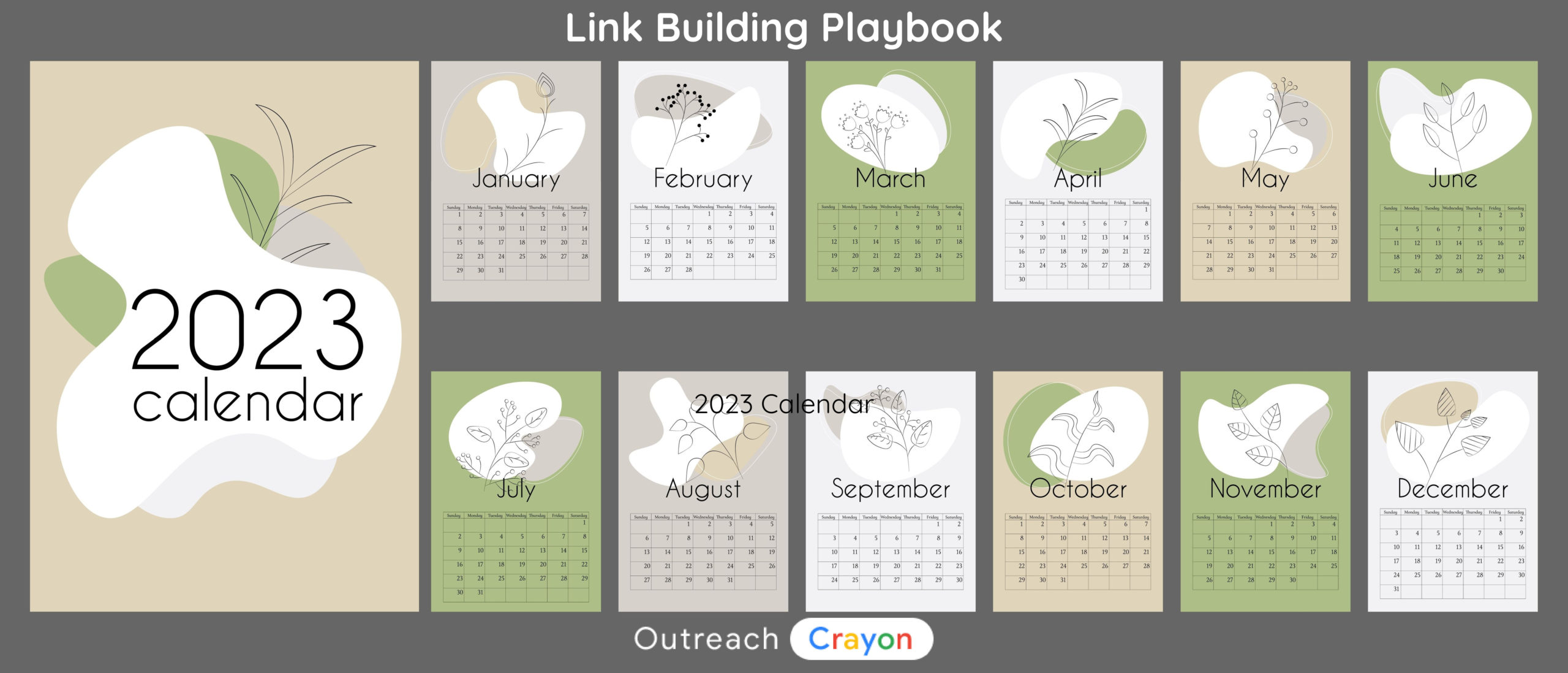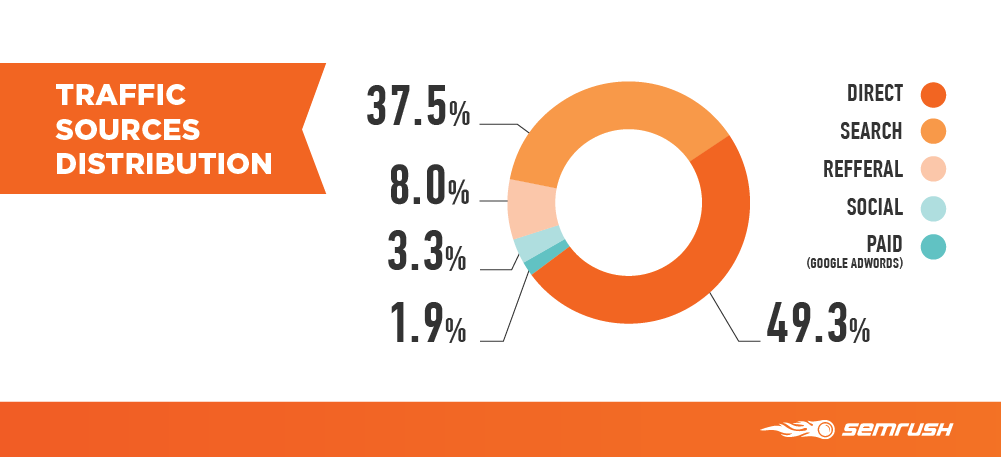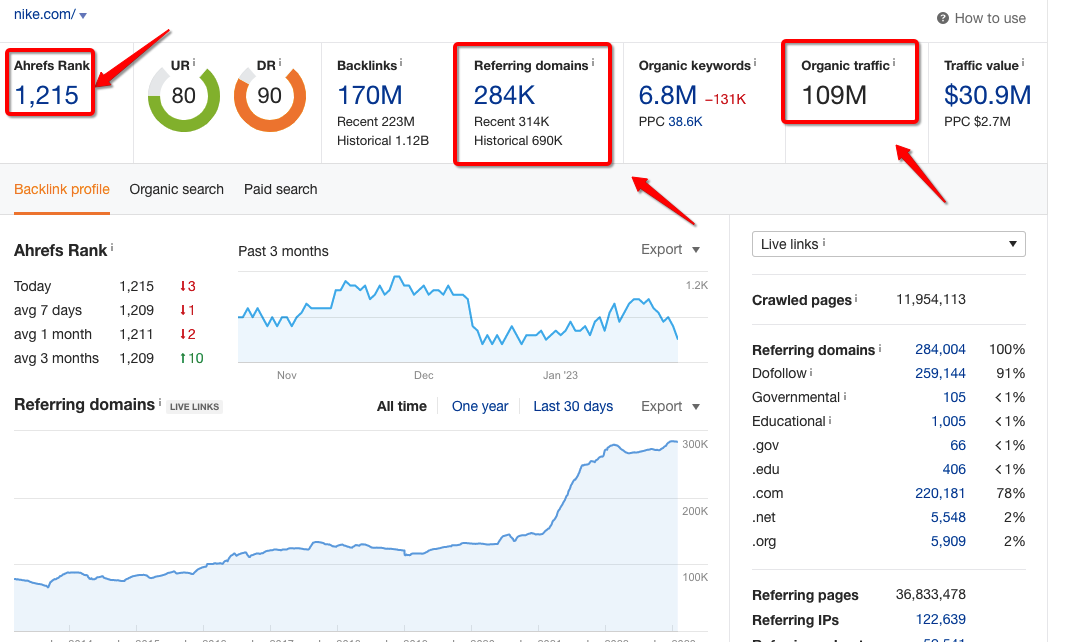
A step-by-step guide to create your Link building 2023 action plan
More than 88% of non-social media online experiences start with a search engine, so for ecommerce stores to be successful online, free traffic (or search engine traffic) plays the most important role.

As per SEMrush, leading ecommerce stores get 37.5% of their traffic through organic searches.
The main target for any ecommerce store is to get ranking on relevant search keywords, i.e. keywords that drive traffic that converts into revenue.
Who will this playbook work for?
Manufacturers / Retailer and SEOs whose task is to get their store profitable online.
We assume you already know about SEO and the importance of Link Building in getting your store ranked online.
There will be a high success rate for stores that sell niche products or products that do not have to complete with big brands on marketplaces like Amazon and Ebay.
What will be covered?
Link building basics & how to build backlinks
03 precise, quantitative ways to measure the impact of link-building
ROI of Link Building
How many backlinks per month should you get in 2023
Link Building Playbook 2023 Calendar
Link building basics & how to build backlinks
Link building is an effective SEO strategy that aims to get other websites to provide contextual links to your own website.

Image Source: Pixabay
Importance of Link Building in SEO
When it comes to website growth and ranking, backlinks are an important factor in SEO, as per 79.7% of SEOs. They are a vote of confidence for your website, indicating to Google that a particular page has more value than other pages on search results.
So, if your goal is to be on the first page of search results for your focus keywords, acquire quality backlinks using a natural link-building strategy.
How to build high-quality backlinks?

Image Source: iStockPhotos
There are numerous ways to increase your website ranking, but link-building is amongst the top of them all. Google places high value on backlinks acquired from reputed websites. Therefore, efforts must be made to make the best of this SEO technique to take your website to new heights. Let’s have a look at some of the ways to build quality backlinks:
1. Make a Killer Content Strategy
Instead of publishing content on trending topics, the focus should be on producing content that provides value to your audience. Evergreen content helps attract quality backlinks which in turn enhances your website ranking. As per 93.8% of link builders, quality matters more than quantity.
2. Analyze Your Competitors
In order to beat your competitors, you need to make the same efforts, as them, in your link-building campaigns. You can analyze their strategy, steal their high-quality backlinks and make your points in the search engine results.
3. Broken Link Building
This is also one of the effective ways to acquire backlinks from a reputed website. All you need to do is use online tools to find broken links of a website that you are interested in. Then, contact the website owner to inform them about the broken link and how you can provide valuable content in replacement.
4. Guest Posting
The guest posting comes with its own advantages. Most of the site owners rely on guest posting to build quality backlinks. You can reach out to websites relevant to your niche, asking them to publish your blog on their website and provide a backlink.
5. Blog Commenting
If you are wondering whether blog commenting will work in 2023, then the answer is YES. The key to this activity is to leave a genuine comment under the post. Otherwise, like others, your comment will also be marked as spam or will get deleted by the owner.
Why do you need link building calendar in 2023?
If you want your website:
- To gain organic traffic
- To increase ranking in SERP
- To enhance domain authority
- To build credibility
Then, you require this link-building calendar. Link building is a long-term process. If you think that you can do a few activities in a week and see the results, then you are wrong. Link building is a consistent process that requires time and effort to make it work.
With the help of link building calendar, you can:
- Keep track of your link-building goals and activities.
- Build a roadmap for your campaigns.
- Boost your backlink profile
- Measure the effectiveness of your link-building campaigns
03 precise, quantitative metrics to measure the impact of your link-building campaign
Effectiveness of link building campaigns can be precisely measured with the growth in three important metrics, Website ranking, referring domains & organic traffic.
It’s a good idea to take a benchmark of these stats before you start your link building campaigns and keep monitoring progress monthly/quarterly.
This will help you track the positive changes of link building to your website stats, if the movement is not good, then it’s time to re-check your keyword strategy.
Let’s have a look at these metrics on a prominent SEO tool, Ahrefs

1. Website Ranking
Website ranking is one of the essential metrics for which you are working on a link-building campaign. You can check your ranking using tools such as Ahrefs, SEMrush, Google Search Console, etc.
Ideally, the best websites are ranked on the first page of Google search engine results. Therefore, your goal should be to be on the first page using a white-label link-building strategy.
2. Referring Domains
The first metric is how many referring domains you got in a month. Though acquiring domains takes time and patience. But once you start working on it, you will get the expected result within 3-4 months.
3. Organic Traffic
The third metric of link building campaign includes keeping a record of your website’s organic traffic growth. Because until and unless you will receive organic traffic, there won’t be an improvement in the website ranking. Google takes time to evaluate your website and make it visible on search engines. So, do your best and let the results speak for themselves.
Is it possible to calculate the ROI of link-building?

Image Source: iStockPhotos
Yes, you can calculate the ROI (Return on Investment) of link-building campaigns.
ROI (Return on Investment) is the profit you earn from spending dollars on your marketing campaigns. You get a positive ROI when you earn more than you invest in the link-building campaign.
Link building should be considered an investment in the website. Therefore, you need to calculate the return you are getting to determine the website’s growth.
Various variables are involved, making it difficult to measure the ROI of link building. However, you must be aware of the results achieved from the campaign.
How will you do it?
Well, as you know, that link building is directly linked with SEO. That means you can measure SEO attributes that will help you arrive at the ROI of the link-building campaign. Let’s have a look at some of the ways to calculate:
- Boost in Organic Traffic: Your organic traffic will automatically improve once you get high-quality backlinks from trusted and genuine websites.
- Increase in Conversion Rates: Your website’s conversion rate will increase if you get backlinks from websites relevant to your niche. This maximizes the chances of driving the target audience to your website.
- Improved Ranking: Once your organic traffic and conversion rates increase, your website will start gaining a higher position in the search results.
How to calculate Return on Investment (ROI) of campaigns?
1. Short Term
You must be aware that link building takes time to show results. It is only after a few months or so that you start seeing traffic on your page. You can use Google Analytics to set up conversions accurately to see if there is an increase in value or not.
Let’s take a date range of 8 months. Now, apply the formula below:
Total Organic Revenue/Organic Sessions
You get a dollar value for all the sessions that you have selected.
Value of Organic Traffic
Organic traffic refers to the audience who come directly to your website from search engine results.
In terms of SEO, getting organic traffic is a big deal as there is so much competition in the market that ranking your page on the first two pages of Google takes a lot of work.
Well, let’s have a look at some of the benefits of organic traffic:
- Drive Relevant Traffic: It’s good to have customers on the website who actually have an interest in your product or services.
- Sustainability: Investing in marketing campaigns to bring traffic is expensive; once you stop the campaign, you will lose all the traffic. Therefore, organic traffic is best. Though it takes time, the results are worth the effort.
- Competitive Advantage: If you want to be ahead of your competitor, then start putting time and money into the efforts to bring organic traffic to the website.
- Establish Credibility: Usually, people ignore paid results and click on organic results on search engines. This is because they give a boost in trust to people.
If you want to make your website a success, then organic traffic is the key. Organic traffic is much more beneficial for a website compared to the traffic attracted through the paid campaign.
2. Long Term
Long terms results are even more challenging to calculate because the value keeps increasing. However, you can still measure the effectiveness with a metric like Domain Authority.
Domain authority is a score that tells the search engine how popular and genuine a particular website is in terms of search engine results.
Increasing your DA will lead to better ranking and help drive relevant traffic to your website. For example, if a website like Moz publishes any content, then there will be an increase in traffic only after a short period of time. This is due to their website’s higher domain authority which establishes a trust that the site is genuine and authentic.
Google Search Console is another way to evaluate your link-building efforts.
You must have an understanding of the functionalities of popular SEO tools, which will make it easier for you to calculate the ROI of marketing campaigns.
Remember that link building is just an aspect of SEO and not the entire SEO. There are other aspects of it which need equal attention to make the website a success.
How many backlinks should one create per month in 2023?
A new website owner must go with 10 links per month to be on the safe side. Using a natural backlinking strategy, they can also go up to 30-40 backlinks per month.
A new website must avoid trying to match the no. of backlinks with older domains because they are already established in the market, so they can easily go with 100 backlinks in a month. In order to not get penalized by Google, you must focus on acquiring high-quality backlinks using a natural link-building strategy.

Referring Domains vs Backlinks Ratio
While getting backlinks, you must remember the ideal ratio between the referring domain and backlink is 1:1. The ratio must always be balanced.
(Ahrefs Screenshot)
Referring domains are used as SEO metrics wherein a backlink is acquired from a unique website to help the target audience reach your website. If your website has few referring domains and lots of backlinks, it will negatively affect your website and send a message to Google that you are not using a white-label link-building strategy.
Hence, to create a strong link-building profile, you must acquire backlinks from unique and high-quality domains using natural link-building techniques which are relevant to your website.
No. of Backlinks You Require to Rank Your Website
The following steps will help you determine how many backlinks you should create to rank:
- Do Keyword Research
Before jumping on any backlinking strategy, you need to do thorough keyword research to find the best keywords to help you reach your target audience. You can also analyze your competitor’s keyword strategy and apply the same to your website to enhance its ranking.
- Determine Keyword Difficulty
Make use of SEO tools like Ahrefs, SEMrush, etc., to check keyword difficulty of the keywords you have gathered using the above step. Compile it in a list to refer to it later.
- Do the Calculations
Now, you have the complete list of keywords you could target. So, the next step includes calculating the no. of backlinks you need to rank your website on Google.
You can use the formula listed below to calculate the backlinks:
The first and foremost step includes finding the average domain authority of all the links that are on your competitor’s website.
For example, let’s take 41 as the average of all the links.
In the next step, compare your DA score to that of the competitor. Take the help of the below chart to find the number:
- For DA 30+ more: -5
- For DA 20-30 more: -3
- For DA 10-20 more: -1
- For DA +/- 10: 0
- For DA 10-20 less: 1
- For DA 20-30 less: 2
- For DA: 30-40 less: 3
- For DA 40-50 less: 5
So, to get ahead of your competitor, make sure you acquire backlinks of websites with domain authority more than your competitor’s average score.
1. Holy Grail SEO
In Arthurian literature, Holy Grail is a cup consisting of magical powers that provide unlimited happiness and abundance. You can use Holy Grail SEO tactics wherein you have to target keywords with high volume and less keyword difficulty to achieve a positive result.
Keyword difficulty is an SEO metric that tells you how hard it is to rank for a particular keyword. The higher the keyword difficulty, the difficult it will be to rank for that keyword. It would be tough for you to win against your competitors because they have already established their niche in the market and, therefore, not worth your time and money.
In order to get results, you must focus on low-keyword difficulty and high-search volume keywords, which will prove to be worth the effort. You can use SEO tools such as Ahrefs, SEMrush, etc., to assess the keyword difficulty and search volume of the keywords and make your choice accordingly.
For example, websites like GoDaddy can easily generate several backlinks within some time by publishing an article. This is because they are high domain authority websites.
Haily Grail SEO will do wonders for any kind of website. With time, you get much more efficient with the research process and will see the magic it creates to provide infinite happiness and abundance.
2. Home Page Brand Trust
The homepage is the core of your website, which lays the foundation for the ranking on search engine results. So, if you don’t put effort into your homepage, any efforts made on the website will go to waste.
In order to establish brand trust, you must acquire high-quality backlinks to your homepage using your brand name. Most of the high domain rating websites have backlinks pointing to their homepage, and the maximum anchor text includes their brand name, which sends a message to Google that their website is genuine.
Thus, if you want to rank on the first page of Google, you have to outperform your competitors in terms of homepage layout, well-written content, and quality backlinks.
3. Focus on Money Pages/Landing Pages or Knowledge Pages/Blogs
You need to differentiate whether your page is a product page (eCommerce platform) or a knowledge page (which includes content).
You can generate lots of backlinks with the help of a knowledge or power page. However, the same cannot be done for the money page.
A power or knowledge page consists of well-written content (usually of 2000-3000 words) with detailed information on a particular topic. This type of content helps provide the solution to your customers. You can naturally insert keywords on the page and acquire quality backlinks from high domain authority websites. However, if you do the same on money pages, Google will catch you.
Google looks for backlinks that are acquired using a natural link-building strategy on well-written content. So, make the smart choice in terms of backlinks.
Businesses can still play their cards right by creating a link juice. You need to build a knowledge page with good content and then interlink it to product pages. This way, all the pages of your website will start ranking.
Link Building Playbook: Create your 2023 Backlink Calendar
You can take the help of link building calendar, which will make it easier for you to track your goals for your website. This will ensure that you are putting all the effort into building high-quality backlinks, which will be fruitful for your website in the long run.
Mentioned below are a few ways that can help you set up a link-building calendar for this year:
- Plan a Strategy: Before starting any link-building campaign, you must decide what you aim to get out of this campaign. It can be anything, including an increase in traffic, higher ranking on Google, boosting website growth, etc.
- Develop a Content Roadmap: Make a list of types of content you will create to fulfil your SEO strategy. The content can be in the form of blog posts, articles, infographics, gifs, videos, etc. Ensure that it is relevant to your business or niche.
- Monitor the Progress: To analyze whether your link-building strategy is showing any positive results, you need to monitor the progress using SEO tools such as Google Analytics, Ahrefs, semrush.
Link-Building Calendar 2023
Let’s divide the calendar into 4 quarters.
If the client wants to rank on 10 keywords, then we will sort the keywords on the basis of their search volume and keyword difficulty. Our focus will be on keywords with low keyword difficulty and higher search volume.
1st Quarter: January, February, March

Focus on 10 keywords and measure the performance after the end of the first quarter.
2nd Quarter: April, May, June

- In the 2nd quarter, we will continue with 50% of keywords that are on the first page.
- We will suggest long-tail keywords for the ones with high keyword difficulty.
3rd Quarter: July, August, September

We will do another review to measure the performance.
- If long-tail keywords start ranking, then the same will be continued in this quarter.
- If not, then we will suggest the client to focus on other keywords.
4th Quarter: October, November, December

In 3rd and 4th quarters, we will target:
- Keywords of 1st and 2nd quarters to rank on 1st page of SERP
- Be in the top 5 for long-tail keywords, which will help to improve the ranking for the keywords with high keyword difficulty.
To make your link-building a success, you have to follow the above calendar and thumb rules. With time and effort, anyone can achieve their goal of ranking their website on the first page of SERP. You have to follow the right path, which we have discussed in this blog.